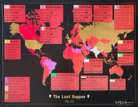
The Last Supper

The Last Supper
Signed Print
Damien Hirst
£1,450-£2,200
$2,900-$4,450 Value Indicator
$2,650-$4,050 Value Indicator
¥13,500-¥21,000 Value Indicator
€1,650-€2,500 Value Indicator
$15,000-$23,000 Value Indicator
¥300,000-¥460,000 Value Indicator
$1,950-$2,950 Value Indicator
There aren't enough data points on this work for a comprehensive result. Please speak to a specialist by making an enquiry.
148 x 197cm, Edition of 150, Lithograph
Auction Results

Track auction value trend
Meaning & Analysis
The Last Supper is a signed offset print in colours produced by renowned artist, Damien Hirst. The print, made in 2005, shows a world map, printed using six different colours. On this map, Hirst labels the thirteen nuclear capable countries. Instead of labelling the countries with their names, Hirst sardonically names them after Jesus and his disciples. The background of the map is dark black, as opposed to the light blue conventionally used to depict the sea on traditional world maps. The countries are rendered in bold red, yellow and purple, giving the map a sinister feel.
The theme of the print is nuclear destruction, with the map detailing the number of nuclear weapons each country has. The print touches on sombre themes of death and destruction, which contrasts with Hirst’s other works which tend to explore the subject of death in a lighter way, such as through the use of animals preserved in formaldehyde or dead insects.
The references to Jesus and his disciplines reflects how, in The Last Supper, Hirst is able to combine religion, war, and death in one print. Hirst often addresses difficult themes and questions through his art. The artist explains,“I am absolutely not interested in tying things down. “Instead, Hirst has continued over the last decade to explore the “big issues” of “death, life, religion, beauty, science.”